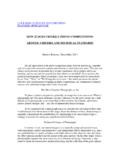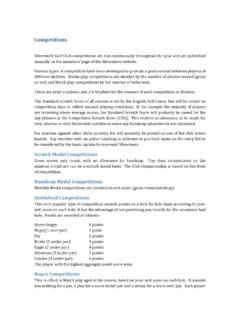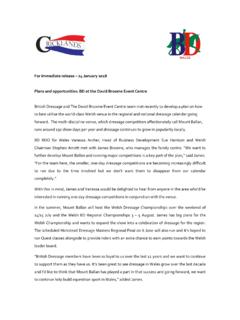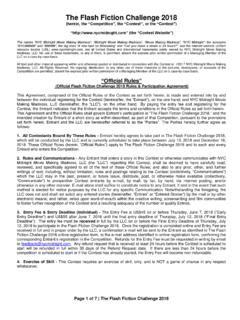Transcription of Safe use of all-terrain vehicles (ATVs) in agriculture …
1 1 of 5 pagesHealth and Safety ExecutiveHealth and Safety ExecutiveAgriculture Information Sheet No 33 (Revision 1)HSE information sheetSafe use of all-terrain vehicles (ATVs) in agriculture and forestry IntroductionThis information sheet gives advice on the safe use of ATVs. It covers the two main types used in off-road working in agriculture , forestry and the land-based industries, namely: Sit-astride ATVs: Any motorised vehicle designed to travel on four low-pressure tyres on unpaved surfaces, with a seat designed to be straddled by the operator and with handlebars for steering control (see Figure 1). These vehicles are intended to be used by a single operator without a passenger. They may also be referred to as quad bikes. Side-by-side ATVs: Small utility vehicles in which the driver and passenger sit alongside each other in conventional (ie sit-in) seats (see Figure 2). Most side-by-side vehicles are capable of carrying two occupants in this way; however, some vehicles are equipped with a second row of seating (and can therefore carry four occupants), while others have bench-style seats allowing up to three people to be seated in a row.
2 The majority of side-by-side vehicles have four wheels, although six-wheel and full and partially tracked versions are also available. There is usually a cargo bed behind the seating area. Side-by-side ATVs are sometimes referred to as utility vehicles (UTVs) or rough terrain utility vehicles (RTVs). ATVs are usually fitted with a tow hitch and are capable of towing a load such as a trailer, a trailed appliance or other types of ATV are designed to cope with a wide variety of terrain types, including steep slopes, but if used outside their safe operating parameters they can very rapidly become unstable. The main causes of serious or fatal injury associated with ATVs are from: being thrown off during vehicle overturns or after loss of control; collisions with structures, trees, other vehicles etc; being trapped/asphyxiated under an overturned machine; pedestrians being struck or run over by factors/underlying causes of accidents and injury with ATVs can include: lack of formal operator training and/or experience; incorrect/lack of appropriate head protection; excessive speed; age of the operator; carrying a passenger on a sit-astride ATV; unbalanced loads or overloading; tipping on a bank, ditch, rut or bump; loss of control on a steep slope combined with other factors, eg ground or load conditions; towing excessive loads with unbraked equipment.
3 Poor maintenance, eg faulty brakes, incorrect tyre pressures measures for sit-astride ATVsTrainingIt is a legal requirement for employers to provide adequate training for employees who use work equipment such as ATVs, and to make sure that only employees who have received appropriate training in their safe use, including the use of any towed equipment or attachments, are permitted to ride them. The same requirements apply to the self-employed. You can get details of suitable training courses from franchised ATV dealers, manufacturers websites, Lantra, the Forestry Commission, EASI (European ATV Safety Institute), the British Off Road Driving Association (BORDA) and through colleges and training purchasing a new or used machine from a franchised dealer an industry-led scheme offers customers free training see Useful contacts .2 of 5 pagesHealth and Safety ExecutiveFigure 1 Example of a sit-astride ATVP ersonal protective equipment the importance of head protection Sit-astride ATVs are not fitted with either a cab or roll bar, so your only protection is what you wear.
4 Head protection is vital. Many ATV fatalities in the UK have been caused by head injuries. Helmets would certainly have prevented most of, if not all, these deaths. You should always wear a helmet when riding an ATV. Helmet types suitable for ATV operations, depending on the circumstances, are motorcycle helmets, equestrian helmets, specialist ATV helmets, cycle helmets and mountaineering helmets. All helmets should be manufactured and tested in accordance with the current relevant EN/BS standard, have a chinstrap and be capable of being used with suitable eye protection. The type of helmet chosen should be based on an assessment of the circumstances in which the ATV will be used, eg the types of surface travelled over and anticipated speeds. The harder the surface and higher the speed the greater the degree of protection needed. NB: Forestry helmets and industrial hard hats are not acceptable for any ATV clothing that is strong and covers your arms and legs.
5 Gloves are useful for protection and handlebar muffs can help to keep hands warm in cold weather for good control of the ATV. Wear sturdy, ankle-covering footwear, eg boots or wellingtons that are strong, supportive and have good wet your eyes from insects and branches with either a visor or The long seat on a conventional sit-astride ATV is to allow operators to shift their body weight backwards and forwards for different slope conditions, a technique known as active riding. It is not for carrying passengers. Manufacturers often display a sign on machines prohibiting passengers and this message is also repeated in operator not carry a passenger in a trailer behind an ATV as any movement can make the machine unstable, particularly with independent rear suspension and trailers with axles wider than the machines have received European Community Whole Vehicle Type Approval, allowing them to be ridden on the public highway. Some of these machines are designed to carry passengers.
6 Such machines may not be suitable for carrying a passenger when used in off-road situations, eg on sloping ground, as the operator may not be able to use active riding techniques to maintain machine stability. Such machines may not have a locking differential and may not provide an acceptable level of traction to ensure safety in certain off-road conditions. Before using an ATV you should assess the suitability of the machine for the intended tasks and working environment. Route planning and stabilityAccidents can occur where ATVs are driven on new routes over steep ground for the first time, or are carrying or dragging destabilising loads. When travelling over rough terrain, get to know your own ground and stick to planned routes where possible. Walk new routes if necessary to check for hidden obstructions, hollows or other hazards. Allow for changes in ground conditions and for the destabilising effect of loads or checks and maintenanceOff-road use is especially harsh on equipment so it is essential to carry out safety checks and maintenance in accordance with the manufacturer s recommendations.
7 In particular, pre-ride safety checks should always include: tyre pressures. These are low, eg typically around 2 7 psi, so even a 1 psi ( kg/cm2) difference in pressure can cause vehicle control problems. Use a gauge that is designed for measuring and displaying low pressures usually supplied with the ATV; brakes and throttle. Check that the brakes give a safe straight stop and that the throttle operates smoothly in all steering positions. Brakes can have a relatively short life in farming or forestry environments and need frequent cleaning, regular adjustment and proper wear suitable head protectionCheck tyre pressures regularlyDon t overload racks3 of 5 pagesHealth and Safety ExecutiveSafe riding methodsOn sit-astride ATVs rider positioning is vital to operate them correctly. The position of the rider on the machine needs to be changed depending on the terrain and motion. Riders must have the ability to move and balance the momentum of the ATV with their own body weight.
8 Plan routes (and review the plan if a route is used regularly) to assess following advice is no substitute for formal training. Most ATVs have no differential and so do not handle in the same way as other machines. This means that when you turn, the ATV tries to keep going in a straight line. When cornering on an ATV with no differential, or with the differential lock engaged, where your body weight needs to be positioned depends on how sharp the corner is and on how fast you are going. Correct body position allows you to transfer weight to the outside of the turn through the footrests while maintaining balance with the torso. This lets the inside wheels skid slightly allowing the ATV to make the turn properly. You must understand how the transmission system of your machine will affect engine braking for both riding on slopes and recovery of stalled ATVs. When riding across a slope, keep your weight on the uphill side of the ATV.
9 When going downhill, slide your weight backwards, select a low gear and use engine braking, reducing the need to use the brakes. When going uphill, it is important to review the route before starting the climb. Move your weight forwards and maintain a steady speed. It is important to shift your body weight forwards as much as possible. If necessary, stand up and lean forward, keeping both feet on the footrests at all times and always maintain momentum. Avoid sudden increases in speed. This is a common cause of rearward overturning accidents, even from a standing start on flat ground where there is good grip. Never put your foot onto the ground to stabilise an ATV when riding, but shift your weight across the ATV away from the imbalance. Always read the owner s equipment and loadsEnsure all riders know the manufacturer s recommended towing capacity and drawbar loading limit. Always operate within these requirements. Remember that your ability to control the ATV by your body movements will be considerably reduced when carrying a load or towing a trailer.
10 When selecting trailed equipment look for: over-run brakes; a swivel hitch drawbar; bead lock rims on wheels; a low centre of gravity and a wide wheel track; a long drawbar; attachment points for securing a load. Check the weight ratio between your ATV and its trailed load. This needs to be assessed for each operation. As a general guide, on level ground braked trailed equipment can be a maximum of four times the unladen weight of the ATV. For unbraked trailed equipment the maximum should be twice the unladen weight. These loads should be reduced when working on slopes, uneven ground or poor surface conditions. Follow the manufacturer s advice for your particular machine. Weight transfer is also important. Stability and resistance to jackknifing is improved if some load is transferred onto the ATV s drawbar. Approximately 10% of the gross weight of the loaded trailer is recommended, but this should not exceed the manufacturer s drawbar loading limit.















